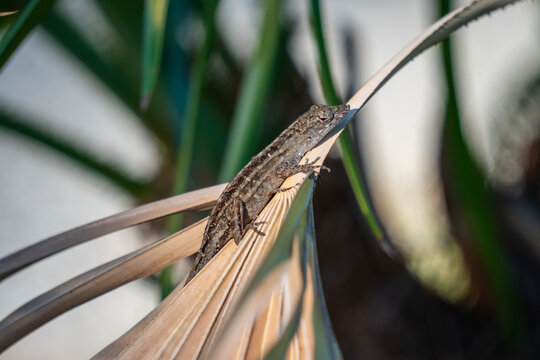ANIMAL: Brown Anole Anolis sagrei Type of Animal: Anole Habitat: Tropical/subtropical disturbed areas, areas w/ open vegetation, open sites/areas, suburban areas, urban areas, neighborhood yards, smaller plant/shrub areas, ground areas, tree areas, tree crowns, tree trunks, shrub/vine/fence/tree areas, fences, building walls, sheltered areas, ornamental plants, potted plants, tropical/subtropical forest edges, hammocks, pinelands, moist forest, scrub forest, savanna, grassland, boats/ships, canoes, kayaks, vehicles, school yards, golf courses, vegetated gas station parking lots, grocery stores, shopping centers Location(s): Native to Cuba, Bahamas, & surrounding islands. Introduced to most other Caribbean islands as well as SE US, Hawaii, S California, Mexico, Central America, parts of South America, & Taiwan. Appearance: Fairly small light brown lizard w/ darker markings on back & lighter coloration on sides. Males larger than females w/ more noticeable dewlaps, juveniles more colorful. Many individuals have grayish coloration as well. Adults can change coloration. Food/Diet: Insects, insect larvae, grubs, spiders, smaller lizards (including juveniles of own species & juveniles of other anoles), lizard eggs, aquatic arthropods, fish, fruit, leafy greens, nectar, vegetables Status in Wild: Stable Lifestyle: Often found in harem groups of a male & around 5 females. Other males solitary. Additional Info: Called: Male Female Young: Hatchling Group: Leap Weight: Male: 0.21-0.28 oz Female: 0.1-0.14 oz Gestation: 2 months Life Span: 3-5 years Body Length: Male: 2-7 in Female: 1.6-4 in Tail Length: Male: 8-8.8 in Female: 7.7-8 in Main predators of adults are other lizards (including larger anole species & larger conspecifics), snakes, birds, carnivorous/omnivorous mammals, tarantulas, wandering spiders, jumping spiders, large centipedes, frogs, crocodilians, predatory katydids, & mantids. Many lizards (including conspecifics & green anoles), spiders, centipedes, whip scorpions, frogs, & Venus flytraps prey on juveniles. Large spiders, mantids, & katydids sometimes eaten by anoles. These lizards have spread from native range due to accidental stowaways in planes/ships/vehicles, escaped pets, plant stowaways, & deliberate release into the wild. In areas shared w/ green anoles, they often displace & compete w/ native greens as well as prey on their young though green anoles prey on young browns as well. In other introduced areas, they introduce parasites/diseases. Invasive in much of introduced range due to adaptability & competing w/ native lizards. Males often head-bob & display dewlap to rivals as well as do push-ups. If this doesn’t work, they’ll wrestle & even bite each other. Sometimes, these fights result in death. Fun Fact(s): These lizards very inexpensive & are often kept as pets. They can detach tail as defense mechanism & removed tail piece can actually continue moving, allowing escape.
